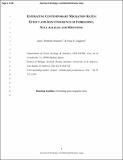Files in this item
Estimating contemporary migration rates : effect and joint inference of inbreeding, null alleles and mistyping
Item metadata
| dc.contributor.author | Robledo-Arnuncio, Juan J. | |
| dc.contributor.author | Gaggiotti, Oscar E. | |
| dc.date.accessioned | 2017-12-17T00:32:04Z | |
| dc.date.available | 2017-12-17T00:32:04Z | |
| dc.date.issued | 2017-01 | |
| dc.identifier.citation | Robledo-Arnuncio , J J & Gaggiotti , O E 2017 , ' Estimating contemporary migration rates : effect and joint inference of inbreeding, null alleles and mistyping ' , Journal of Ecology , vol. 105 , no. 1 , pp. 49-62 . https://doi.org/10.1111/1365-2745.12680 | en |
| dc.identifier.issn | 0022-0477 | |
| dc.identifier.other | PURE: 246572062 | |
| dc.identifier.other | PURE UUID: 7f6194b2-1eee-4700-9bb3-f506d77ed4a5 | |
| dc.identifier.other | Scopus: 85006152256 | |
| dc.identifier.other | WOS: 000390331000006 | |
| dc.identifier.other | ORCID: /0000-0003-1827-1493/work/61370071 | |
| dc.identifier.uri | https://hdl.handle.net/10023/12344 | |
| dc.description | This work was supported by CGL2015-64164-R project from the Spanish Ministry of Economy and Competitiveness and the European Regional Development Fund. Research was partly conducted during a research visit of JJRA to St Andrews University, hosted by OEG and funded by PRX14/00611 mobility grant from the Spanish Ministry of Education, Culture and Sports. OEG was supported by MASTS (the Marine Alliance for Science and Technology for Scotland). | en |
| dc.description.abstract | 1 . Microsatellite-based genetic assignment is used broadly to monitor contemporary effective dispersal among populations. The need to investigate the robustness of this method to common genotyping errors was emphasized more than a decade ago, but it remains unaddressed. 2 . We evaluate here for the first time the effect of mistaken and null alleles on estimates of contemporary seed and pollen migration rates obtained with genetic assignment methods. We also introduce a novel Bayesian approach to jointly estimate seed and pollen migration rates, genotyping error rates and null allele frequencies, not requiring independent reference or duplicate genotypic data. 3 . Unaccounted-for mistaken alleles caused positive bias and increased the root mean square error (RMSE) of pollen migration rate estimates, whereas seed migration rate estimates were weakly sensitive to mistyping. Jointly estimating mistyping rates minimized the bias and RMSE they introduce on pollen migration estimates, while yielding seed migration rate estimates with similar or slightly larger bias and RMSE than those obtained when ignoring mistyping. 4 . Ignoring genotyping errors can be especially problematic when there is no actual migration, because it can lead to the wrong conclusion that there is statistically significant exchange of pollen and/or seeds among populations that are actually isolated. 5 . Unaccounted-for null alleles are problematic when among-population pollen dispersal is present, leading to underestimation of pollen migration rates and overestimation of seed migration rates. Jointly estimating null allele frequencies minimized these two biases, reduced the RMSE of seed migration rate estimates and produced relatively small changes in the RMSE of pollen dispersal estimates. 6 . Synthesis. Disregarding genotyping errors and null alleles can produce biased and less accurate estimates of the rates at which present-day plant populations are exchanging seed and pollen. An approach is proposed here to minimize the effect of genotyping problems on contemporary migration rate estimates, which should help avoiding erroneous migration inference, monitoring and management, especially when dealing with low migration rates and their associated uncertainty. | |
| dc.format.extent | 14 | |
| dc.language.iso | eng | |
| dc.relation.ispartof | Journal of Ecology | en |
| dc.rights | © 2016, The Authors. British Ecological Society. This work has been made available online in accordance with the publisher’s policies. This is the author created, accepted version manuscript following peer review and may differ slightly from the final published version. The final published version of this work is available at onlinelibrary.wiley.com / https://doi.org/10.1111/1365-2745.12680 | en |
| dc.subject | Bayesian inference | en |
| dc.subject | Dispersal | en |
| dc.subject | Gene flow | en |
| dc.subject | Genetic assignment | en |
| dc.subject | Genotyping errors | en |
| dc.subject | Pollen and seeds | en |
| dc.subject | Microsatellite | en |
| dc.subject | QH301 Biology | en |
| dc.subject | QH426 Genetics | en |
| dc.subject | DAS | en |
| dc.subject.lcc | QH301 | en |
| dc.subject.lcc | QH426 | en |
| dc.title | Estimating contemporary migration rates : effect and joint inference of inbreeding, null alleles and mistyping | en |
| dc.type | Journal article | en |
| dc.description.version | Postprint | en |
| dc.contributor.institution | University of St Andrews. School of Biology | en |
| dc.contributor.institution | University of St Andrews. Marine Alliance for Science & Technology Scotland | en |
| dc.contributor.institution | University of St Andrews. Scottish Oceans Institute | en |
| dc.identifier.doi | https://doi.org/10.1111/1365-2745.12680 | |
| dc.description.status | Peer reviewed | en |
| dc.date.embargoedUntil | 2017-12-16 |
This item appears in the following Collection(s)
Items in the St Andrews Research Repository are protected by copyright, with all rights reserved, unless otherwise indicated.

